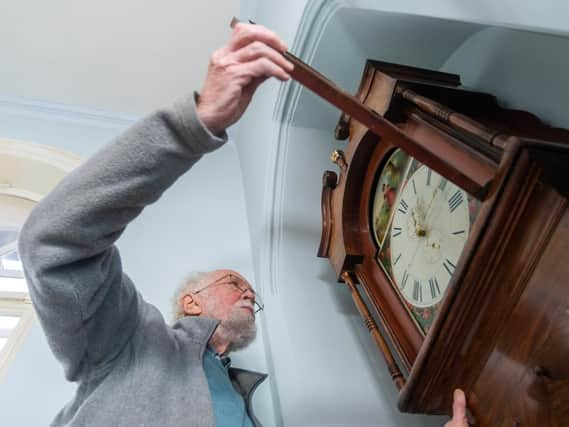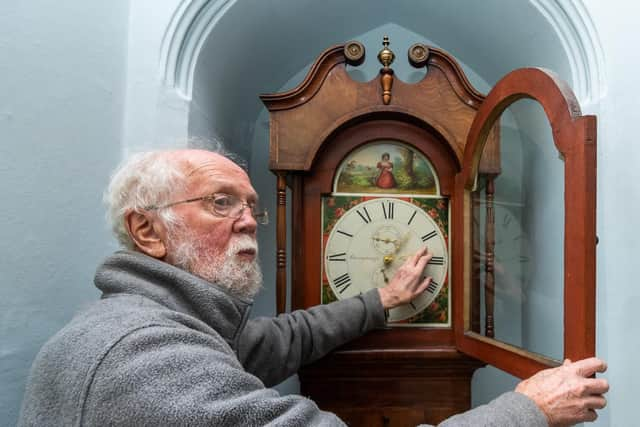Grandfather clock part of evening ritual for father of Brontë sisters restored at Haworth Parsonage


The 19th century clock was part of the evening ritual for the father of Britain’s most famous literary family, as he would stop religiously every evening to wind it up on the stroke of 9pm as he made his way upstairs to bed.
And the 6ft tall timepiece, which was made by Barraclough of Haworth, has taken on an added resonance in the museum that is now housed in the former Brontë family home.
Advertisement
Hide AdAdvertisement
Hide AdIt has just been returned to the Brontë Parsonage in Haworth after being restored, an annual task that was abandoned last year as the first lockdown was imposed.


The clock remained silent throughout the intervening 12 months, but it is now back on the staircase after being cleaned and conserved, its distinctive ticking resonating around the museum.
For the Parsonage’s chief curator, Ann Dinsdale, it is a moment that signifies a renewed hope for the future as the museum’s staff and volunteers prepare to re-open to the public next month.
She told The Yorkshire Post: “The Parsonage has been eerily quiet for so long now, but to have the clock back and ticking again is wonderful. It really is a big moment for us all, as it is symbolic that the museum is about to re-open to the public again.”
Advertisement
Hide AdAdvertisement
Hide AdThe work was carried out by David Barker, a fellow of the British Horological Institute and one of only a handful of accredited clock conservators in Britain.
He said: “I have been working on the Parsonage’s clocks for 30 years, and I have enjoyed connecting with them again. It is nice to know that the clock is back where it should be, and working again.”
The Parsonage is set to welcome back its first visitors again on May 19, and anyone passing through the entrance will be given unprecedented access to witness some of the 7,000 artefacts which are in the museum’s collection.
Visitor numbers will be limited to just six people every 15 minutes, meaning that the venue will be free of the crowds who normally pack into its corridors and rooms.
Advertisement
Hide AdAdvertisement
Hide AdEach year, as many as 80,000 visitors descend on the Parsonage from across the world, including many from the USA, Japan and China, although admissions will be dramatically scaled back to adhere to social distancing regulations.
Ms Dinsdale said: “We obviously want people to be able to enjoy the Parsonage safely, so that means people will be able to see the exhibits on show in a manner which is definitely a break from the norm.
“It really will be a special time for anyone coming to visit, and we are just so glad to be able to welcome people back once again.”
Among the highlights once the museum re-opens will be the exhibition marking the bicentenary of Anne Brontë’s birth, which has been extended into this year after the Parsonage was forced to close in 2020.
Advertisement
Hide AdAdvertisement
Hide AdAmong the other artefacts on display will be five of the six “little books” which were written by Charlotte Brontë when she was aged just 14.
The Brontë Society paid €600,000 for one of the tiny manuscripts at a Paris auction in November 2019, following a public appeal for funds.
The book, called The Young Men’s Magazine, has more than 4,000 hand-written words in a meticulously folded and stitched magazine. It was one of a series of six booklets, of which five are known to survive.
Built between 1777 and 1778, the Parsonage’s moorland setting was to have a profound influence on the writings of Charlotte, Emily and Anne Brontë.
Advertisement
Hide AdAdvertisement
Hide AdTheir father, Patrick, moved into the property in Haworth in 1820 with his wife and six children when he was appointed as the rector of St Michael and All Angels’ Church in the village.
It was to remain his home up until his death in 1861, after he had outlived his wife and all of his children.
The Parsonage, which is a Grade I listed building, is now home to the museum dedicated to the lives of the Brontë sisters, who were responsible for cherished novels such as Wuthering Heights, Jane Eyre and The Tenant of Wildfell Hall.
The Brontë Society, which is one of the oldest literary societies in the world, supports the preservation of the museum and its library collections.
Advance bookings will be required for anyone visiting the Brontë Parsonage, and more details are available at the official website at https://www.bronte.org.uk/visit-us or by calling 01535 642323.